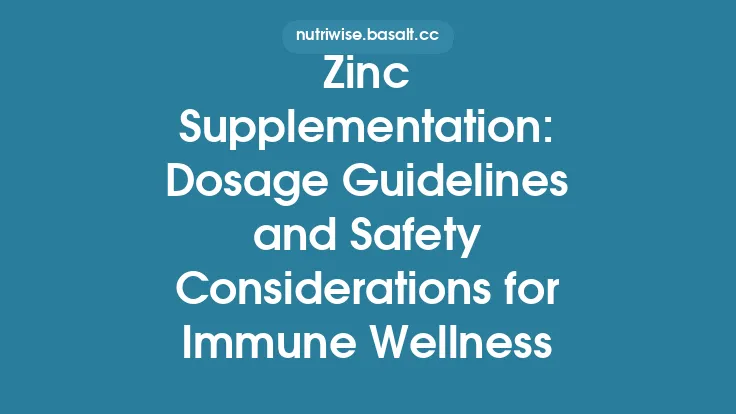When it comes to supporting the growth, development, and everyday performance of children and teenagers, nutrition is the foundation. Whole‑food diets that provide a variety of fruits, vegetables, whole grains, lean proteins, and healthy fats should always be the primary source of vitamins, minerals, and other bioactive compounds. However, modern lifestyles, picky eating habits, and increased physiological demands (e.g., rapid growth spurts, intense school or extracurricular activities) can create shortfalls that are difficult to fill through diet alone. In these cases, carefully selected dietary supplements can serve as a safe, evidence‑based bridge to optimal nutrient status—provided that parents, caregivers, and health professionals follow a structured, age‑appropriate approach.
Understanding the Unique Nutritional Needs of Growing Bodies
Growth velocity and nutrient demand
Children and adolescents experience distinct phases of rapid growth: infancy, early childhood, pre‑puberty, and the adolescent growth spurt. During each phase, the body’s requirement for macronutrients (protein, essential fatty acids) and micronutrients (calcium, iron, zinc, vitamin D, B‑vitamins) can increase dramatically. For example, the Recommended Dietary Allowance (RDA) for calcium jumps from 1,000 mg/day in early childhood to 1,300 mg/day during the peak adolescent years to support skeletal mineralization.
Neurodevelopmental considerations
The brain continues to mature well into the mid‑twenties. Nutrients such as omega‑3 fatty acids (particularly DHA), iron, iodine, choline, and certain B‑vitamins are critical for myelination, neurotransmitter synthesis, and cognitive function. Deficiencies in these nutrients have been linked to attention deficits, learning difficulties, and mood disturbances.
Hormonal changes and metabolic shifts
Puberty triggers hormonal cascades that affect insulin sensitivity, lipid metabolism, and bone turnover. These changes can alter the way the body processes nutrients and may increase the risk of temporary imbalances (e.g., iron deficiency anemia in menstruating girls, transient vitamin D insufficiency during rapid bone growth).
Core Supplements with Strong Evidence for Children and Teens
| Nutrient | Primary Role | Typical Age‑Specific Dosage (RDA/AI) | Key Food Sources | When Supplementation May Be Warranted |
|---|---|---|---|---|
| Vitamin D | Calcium absorption, bone health, immune modulation | 600 IU (0‑12 yr), 800 IU (13‑18 yr) | Fatty fish, fortified milk, sunlight | Limited sun exposure, darker skin, high latitude, obesity |
| Calcium | Skeletal development, muscle contraction | 1,000 mg (4‑8 yr), 1,300 mg (9‑18 yr) | Dairy, fortified plant milks, leafy greens | Dairy avoidance, lactose intolerance, vegan diet |
| Iron | Hemoglobin synthesis, oxygen transport, neurodevelopment | 7 mg (7‑12 yr), 8 mg (13‑15 yr), 15 mg (girls 12‑18 yr) | Red meat, beans, fortified cereals | Menstruating adolescents, vegetarian/vegan diets, documented anemia |
| Omega‑3 (DHA/EPA) | Brain and retinal development, anti‑inflammatory | 250 mg DHA + EPA combined (4‑8 yr), 300‑500 mg (9‑18 yr) | Fatty fish, algae oil | Low fish intake, picky eaters, ADHD concerns |
| Zinc | Immune function, DNA synthesis, growth | 5 mg (4‑8 yr), 8 mg (9‑13 yr), 11 mg (boys 14‑18 yr), 9 mg (girls 14‑18 yr) | Meat, nuts, whole grains | Limited animal protein, chronic diarrhea |
| Iodine | Thyroid hormone production, neurodevelopment | 90 µg (4‑8 yr), 120 µg (9‑13 yr), 150 µg (14‑18 yr) | Iodized salt, dairy, seaweed | Low iodized salt use, restrictive diets |
| Vitamin B12 | Myelin formation, red blood cell production | 1.2 µg (4‑8 yr), 1.8 µg (9‑13 yr), 2.4 µg (14‑18 yr) | Animal products, fortified foods | Vegan/vegetarian diets, malabsorption |
These nutrients have the most robust data supporting supplementation when dietary intake is insufficient. The dosages listed align with the Institute of Medicine (now the National Academy of Medicine) RDAs and are generally considered safe when taken as a single daily dose.
Choosing the Right Formulation for Young Consumers
- Chewable tablets and gummies – Popular for their palatability, but they often contain added sugars, artificial flavors, and may have lower bioavailability for certain minerals (e.g., iron). Opt for products with ≤5 g of total sugars per serving and minimal additives.
- Liquid drops or syrups – Useful for infants, toddlers, or children who have difficulty swallowing pills. Ensure the liquid is free of alcohol, propylene glycol, and contains a reliable carrier oil (e.g., MCT oil for fat‑soluble vitamins).
- Powdered mixes – Can be blended into smoothies or oatmeal. Verify that the powder is free from cross‑contamination with allergens and that the serving size is clearly defined.
- Capsules or tablets – Best for older teens who can swallow pills. Look for enteric‑coated formulations for nutrients that may cause gastric irritation (e.g., iron).
Key quality markers
- Third‑party testing (e.g., USP, NSF, ConsumerLab) confirming label claim accuracy and absence of heavy metals, pesticides, or microbial contaminants.
- Transparent sourcing (e.g., wild‑caught fish oil, algae‑derived DHA, non‑GMO plant extracts).
- Stability guarantees (e.g., vitamin D3 in oil base, iron bisglycinate for reduced oxidation).
Safety First: Avoiding Over‑Supplementation and Interactions
Upper intake levels (ULs)
Children have lower tolerances for excess nutrients. For instance, the UL for iron in children 4‑8 yr is 40 mg/day, while for adolescents it is 45 mg/day. Chronic intake above the UL can cause gastrointestinal distress, oxidative stress, and, in severe cases, organ toxicity.
Potential drug‑nutrient interactions
- Antacids or proton‑pump inhibitors can reduce absorption of iron and calcium.
- Certain antibiotics (e.g., tetracyclines, fluoroquinolones) bind to calcium and magnesium, decreasing their efficacy.
- Thyroid hormone replacement may be affected by high doses of iodine or calcium.
Allergy and sensitivity considerations
Even though the article avoids a dedicated “allergy‑friendly” focus, it is prudent to screen for common allergens (milk, soy, gluten, nuts) in supplement formulations, especially for children with known sensitivities.
Monitoring and follow‑up
- Baseline labs (e.g., serum ferritin, 25‑hydroxy vitamin D, zinc) before initiating long‑term supplementation.
- Periodic reassessment every 6‑12 months to adjust dosage or discontinue if levels normalize.
- Clinical signs such as changes in growth velocity, skin/hair health, energy levels, and academic performance can guide the need for continued supplementation.
Integrating Supplements into a Healthy Lifestyle
- Timing matters – Fat‑soluble vitamins (A, D, E, K) and omega‑3s are best absorbed with meals containing dietary fat. Iron is optimally taken on an empty stomach (or with vitamin C) but may cause nausea; a small amount of fruit juice can improve tolerance.
- Balanced diet synergy – Encourage a “food first” mindset. For example, pairing iron‑rich foods with vitamin C sources (citrus, bell peppers) enhances absorption, reducing the need for high supplemental doses.
- Physical activity – Regular weight‑bearing exercise supports calcium utilization, while aerobic activity can improve vitamin D synthesis through outdoor exposure.
- Sleep hygiene – Adequate sleep is essential for growth hormone release; deficiencies in magnesium or B‑vitamins can impair sleep quality, creating a feedback loop that may be mitigated with targeted supplementation.
Special Situations Requiring Tailored Supplement Strategies
| Situation | Nutrient(s) of Concern | Recommended Approach |
|---|---|---|
| Picky eaters | Calcium, iron, vitamin D, omega‑3 | Start with a low‑dose, palatable gummy or liquid; monitor for excess sugars. |
| Vegetarian/vegan adolescents | Vitamin B12, iron (heme), calcium, DHA/EPA, zinc, iodine | Use algae‑derived DHA/EPA, fortified B12 tablets, calcium citrate, and consider a multivitamin with methylcobalamin and iron bisglycinate. |
| Obese children | Vitamin D (sequestration in adipose tissue), zinc | Higher end of the RDA for vitamin D (up to 1,000 IU) after checking serum levels; zinc as zinc picolinate for better absorption. |
| Adolescents with intense academic or extracurricular schedules | B‑vitamins, magnesium, adaptogenic botanicals (e.g., ashwagandha) | B‑complex (methylated forms) for energy metabolism; magnesium glycinate for relaxation; botanical adaptogens only after pediatric consultation. |
| Children with chronic gastrointestinal conditions (e.g., celiac disease, inflammatory bowel disease) | Iron, calcium, vitamin D, zinc | Use chelated mineral forms (iron bisglycinate, calcium citrate) and consider a comprehensive pediatric multivitamin formulated for malabsorption. |
Practical Checklist for Parents and Caregivers
- Assess dietary patterns: Keep a simple food diary for a week to identify gaps.
- Consult a qualified professional: Pediatrician, registered dietitian, or pediatric nutrition specialist.
- Select a reputable product: Look for third‑party verification, clear dosage instructions, and age‑appropriate labeling.
- Start low, go slow: Begin with the minimum effective dose; increase only if labs indicate a deficiency.
- Track outcomes: Record any changes in energy, mood, school performance, and growth metrics.
- Re‑evaluate annually: Nutrient needs evolve with growth; what was appropriate at age 8 may differ at age 15.
Frequently Asked Questions
Q: Can my teen take adult multivitamins?
A: Adult formulations often contain higher levels of certain nutrients (e.g., iron, vitamin A) that exceed the UL for adolescents, increasing the risk of toxicity. Choose a product specifically labeled for the 4‑18 yr age range.
Q: Are “natural” or “herbal” supplements safer for kids?
A: “Natural” does not guarantee safety. Many botanicals lack pediatric dosing data and can interact with medications. Always seek professional guidance before introducing any herbal product.
Q: How do I know if my child needs a supplement?
A: Signs such as unexplained fatigue, frequent infections, poor wound healing, brittle nails, or delayed growth may hint at a deficiency, but laboratory testing is the gold standard for confirmation.
Q: What about probiotic supplements?
A: Probiotics can support gut health, especially after antibiotic courses, but the evidence for routine use in healthy children is mixed. If considered, select a strain‑specific product with documented pediatric research.
Q: Is it okay to give my child a vitamin D supplement year‑round?
A: Yes, especially in regions with limited sunlight during winter months. Seasonal dosing can be adjusted based on serum 25‑hydroxy vitamin D levels.
Looking Ahead: Emerging Research and Future Directions
The field of pediatric supplementation is evolving rapidly. Recent studies are exploring:
- Personalized nutrition using genetic markers (e.g., MTHFR polymorphisms influencing folate metabolism) to fine‑tune B‑vitamin dosing.
- Nano‑encapsulation technologies that improve the bioavailability of fat‑soluble vitamins and omega‑3s, potentially allowing lower doses with the same efficacy.
- Microbiome‑targeted pre‑ and probiotic blends designed to enhance nutrient absorption (e.g., iron‑absorbing bacterial strains).
While these innovations hold promise, they remain largely investigational. Until robust safety and efficacy data are available, the cornerstone of pediatric supplement strategy should stay grounded in evidence‑based nutrients, age‑appropriate dosing, and vigilant monitoring.
By approaching supplementation with a clear understanding of growth‑related nutrient demands, a commitment to product quality, and a partnership with qualified health professionals, parents and caregivers can confidently support the health and potential of children and teens—helping them thrive today and laying a solid foundation for lifelong well‑being.





